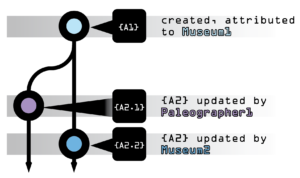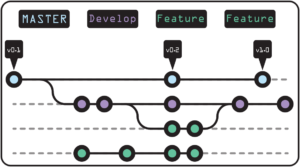Versioning in RERUM
Versioning as it is known in software is simply the process of preserving previous iterations of a document when changes are made. There are many systems available to the developer which differ in centralization, cloning behaviors, delta encoding, etc., but for our purposes, the philosophy and utility should suffice.
From a mile up, versioning resembles different editions of a published work. Even when the new work supersedes the previous, both are maintained so that they can be cited reliably and the changes between them may become an interesting piece of the academic conversation as well. In the digital world, new versions can come quickly and the differences between them are often quite small. However, in an ecosystem like Linked Open Data, that presumes most resources are remote and have a permanent and reliable reference, even small gaps can magnify and create dysfunction.
Permanent Reference

The idea of a PURL for resources on the Internet is an old one. Most HTML pages for records in a collection include a “reference URL” or “cite as” which indicates to the user how to reliably return to the object being viewed. With RERUM, we want to extend the courtesy of a stable home to sc:Manifest, oa:Annotation, and similar objects that are more often viewed only as attached to resources like books, paintings, and other records of “real things.”
Upon creation in RERUM, an object (henceforth an annotation, for ease of example) is minted a novel URI (@id, in JSON-LD) where it will always be available. Whenever a trusted application makes a change, a new version is saved and given a new URI, connected to the previous annotation. In most cases, the significant changes will be to the oa:hasBody or oa:hasTarget fields, but any altered property may make an existing reference unreliable, so the new URI is returned to the application while the old reference remains stable.
Branches: the family tree of digital objects
In the wide world, it is likely that two or more applications may be referencing and even updating the same annotation for different reasons. As an example, let’s consider transcription annotations made in a standards-compliant application, such as TPEN, and Mirador, an open viewer for IIIF objects. A museum may digitize a manuscript and open it up for public transcription, creating many varied annotations throughout the document, identifying image fragments and text content. In RERUM, these annotations are not only associated with each other in the Manifest shared by the museum, but every individual annotation attributes itself to the application (if not the user) that created it or offered updates. This case for versioning is simple to see and accommodate.
Now a prestigious paleographer comes along wishing to complete an authoritative edition of this manuscript. She will begin a project in the transcription application using all of the annotations that existed at the time. As she goes through and applies corrections and conventions for expansions and spelling and punctuation, she is updating the annotations, but in her own project, not that of the public project from the museum. This works because the museum projects annotations still exist and the references to them have not changed. If someone else suggests a change to an annotation for which the paleographer has already created a more recent version, the history of the annotation branches, allowing both current versions to share ancestry without collision.
Timeline Breakdown
1. Created four lines on a page in the museum project:
{A1:Museum1}, {A2:Museum1}, {A3:Museum2}, {A4:Museum1}
2. The paleographer begins work and makes a change on the second line:
{A1:Museum1}, {A2.1:Paleographer1}, {A3:Museum2}, {A4:Museum1}
but the museum project remains unchanged.
3. When Museum2 corrects an error in Museum1’s transcription (cooincidentally the same error the paleographer caught):
{A1:Museum1}, {A2.2:Museum2}, {A3:Museum2}, {A4:Museum1}
the public project is updated without breaking the paleographer’s edition.
So the history of A2 looks like this:

Now the model works for everyone. The museum has an open project, the paleographer has a project she controls, and every contribution through history is automatic. The problem that has been introduced, however, is how should a Manifest viewer display these annotations? To show them all in all their versions would quickly overwhelm, but depending on the moment the “most recent” annotation may be from either branch. Moreover, the paleographer may not intend for these annotations, though stored in an open repository, to be considered a finished project, suitable for display or citing. The simplest answer is that a repository can publish their Manifest with all the intended annotations included, but that undermines the possibilities of an open store.
Digital “Micropublishing”
RERUM supports and encourages the use of a few oa:Motivations that have not been used before. In addition to the Motivation on each well-formed annotation that should indicate whether it is a transcription, translation, comment, edit, etc. applications may apply rr:working or rr:releasing. Not having either of these Motivations means nothing—it is simply unhelpful, and is the default of current encoding platforms. The thinking up to this point has been that annotations would always be sequestered until they are ready for publication and anything found in the wild is official. Linked Open Data, however, thrives on connections and the interesting things that can happen when many iotas of half-completed assertions and descriptions hit critical mass. As a platform, RERUM cannot hide anyone’s work and sincerely commit to open data and interoperable exchange, but it would be foolish to release users’ assertions into the wild knowing that convention assumes these objects have been imbued with a complete academic soul.
The rr:working Motivation is simple. The statement is just that the content of the annotation is not intended for publication—it is shared in good faith for use in discovery or as a seed for further work only. An rr:working object is subject to change and may be completely reversed, disowned, or deleted in the future. It is just a conversation over coffee, albeit one that establishes history and maintains full attribution in its encoding.
The rr:releasing Motivation is not the inverse of rr:working, though they are semantically exclusive. It is a full mark of confidence from the creator and assurance from RERUM that it will be available at this location in perpetuity. When an application marks something as published, no changes may be made to it—full stop.
In this way, strange new combinations of publications may arise. A museum may “publish” their Manifest, offering their imprimatur on the canvases, labels, and descriptions within. Then this Manifest may be offered up for crowd-sourced transcription without also implying that the museum stands behind the evolving transcription data. A scholar who is working their way through a difficult document can publish a chapter on which he would like to plant his flag while continuing to work on the rest of the document, years before publishing the critical edition of the work. It should be noted that RERUM does not require these motivations be included in the main body of the object if the schema is being controlled and utilizes properties in the __rerum property covered in the API to raise the same effect.
Postscript: overwrite
This final option for applications is unique to digital objects and to be used very sparingly. By throwing the ?overwrite switch when making an update request, the application acknowledges that the existing version of the object is flawed or so irrelevant as to be useless. In this case only, there is no new version made; the original is updated and the private __rerum metadata is updated with the date of the overwrite. Most cases where this is required, best practices should have handled it before committing the change, but RERUM acknowledges that human error will sometimes undermine machine obedience.
